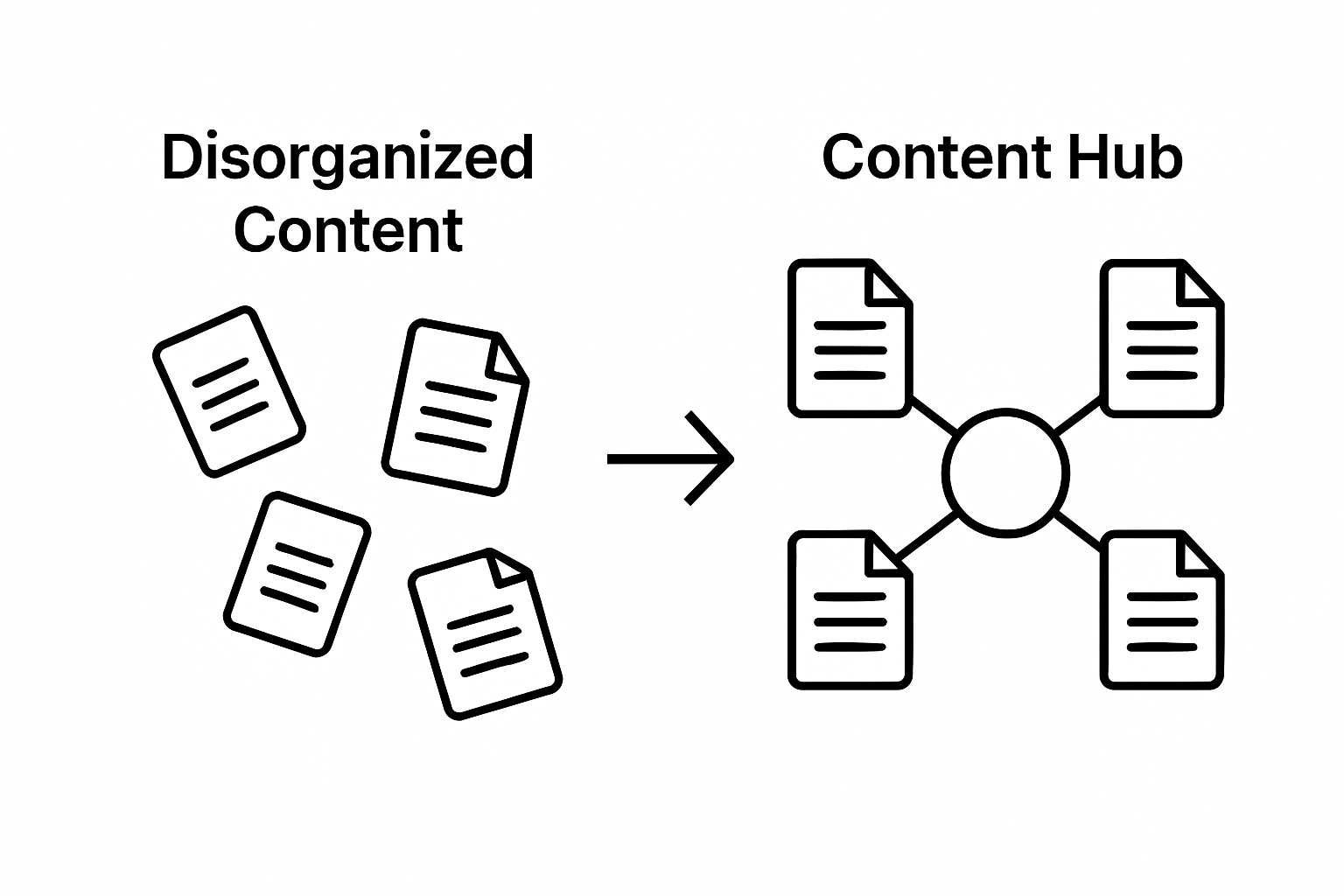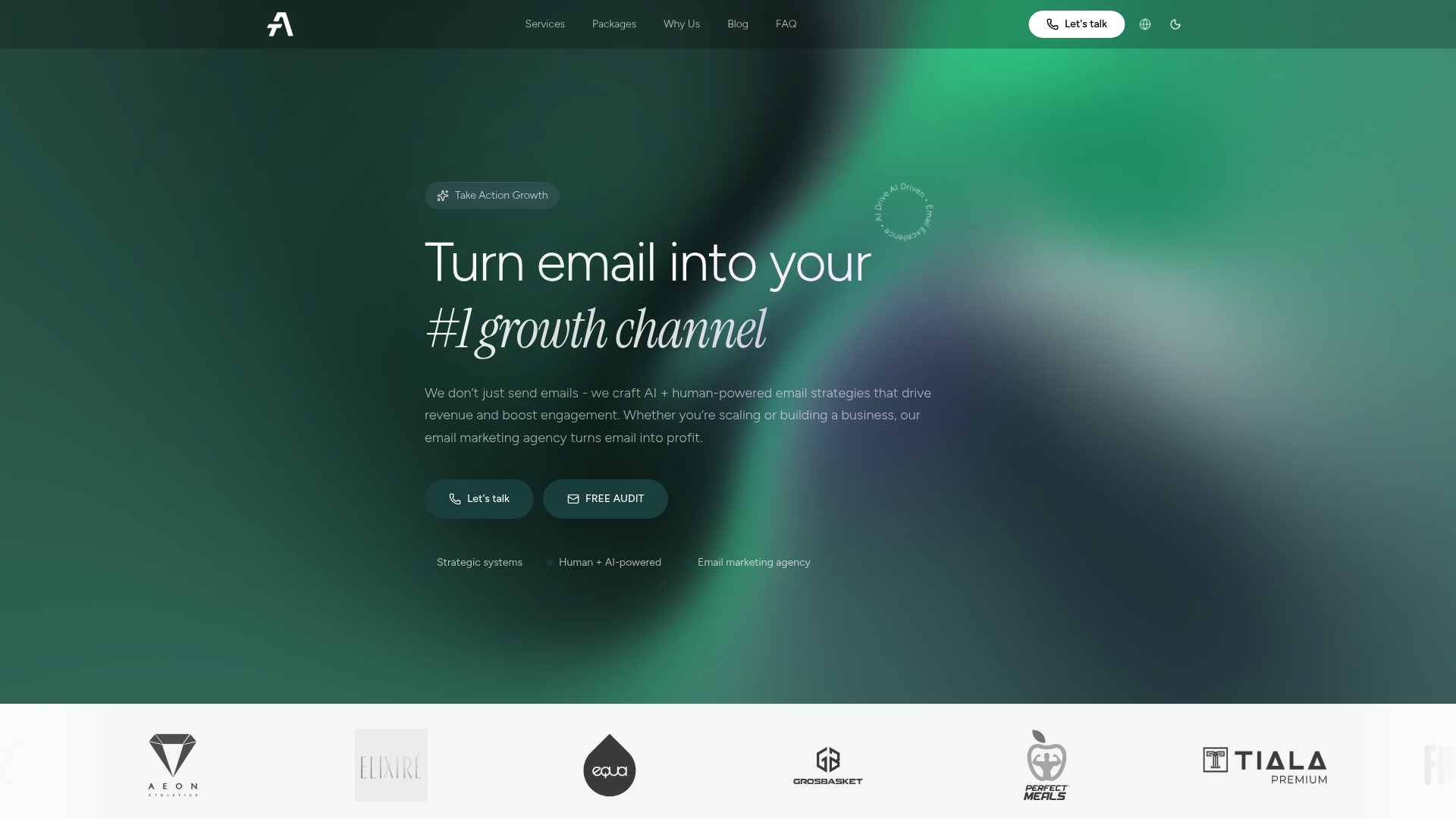What is a Content Hub? Understanding its Importance
Content hubs are changing how brands organize information online. Surprisingly, brands using content hubs see up to 40 percent more organic traffic than those who do not. Instead of just collecting articles in one place, the real power of a content hub is how it builds trust and drives real connections far beyond traditional website pages.
Table of Contents
- Defining A Content Hub And Its Purpose
- The Significance Of Content Hubs In Ecommerce
- How Content Hubs Enhance Customer Retention
- Key Elements Of A Successful Content Hub
- Real-World Examples Of Content Hubs In Action
Quick Summary
| Takeaway | Explanation |
|---|---|
| Content hubs centralize valuable information | They serve as comprehensive resource centers focused on specific themes, providing in-depth insights for users. |
| Integrate pillar and cluster content | Combining long-form overview articles with detailed subtopics enhances user experience and content interconnectedness. |
| Build brand trust through education | By offering resources and product understanding, content hubs can reduce customer support and enhance confidence in the brand. |
| Optimize for SEO with interconnected content | Strategic content organization helps improve search visibility by targeting multiple long-tail keywords effectively. |
| Focus on ongoing value for customer retention | Consistently delivering high-quality content fosters loyalty, transforming casual visitors into long-term customers. |
Defining a Content Hub and Its Purpose
A content hub represents a strategic digital platform designed to centralize and organize high-quality, interconnected content around a specific theme or topic. Unlike traditional website pages, a content hub serves as a comprehensive resource center that offers in-depth, valuable information for users seeking authoritative insights on a particular subject.
Core Components of a Content Hub
At its foundation, a content hub typically includes several critical elements that distinguish it from standard web content. These components work together to create a cohesive and user-friendly experience:
- Pillar Content: Comprehensive, long-form content that provides an overarching overview of the central topic
- Cluster Content: Detailed supplementary articles that explore specific subtopics in greater depth
- Strategic Internal Linking: Interconnected content that guides users through related information seamlessly
Strategic Purpose and Business Value
Businesses and brands leverage content hubs as powerful marketing tools that serve multiple objectives. According to Content Marketing Institute, content hubs enable organizations to establish thought leadership, improve search engine optimization, and create meaningful engagement with their target audience.
A well-designed content hub goes beyond simple information aggregation. It transforms complex subjects into digestible, interconnected resources that provide genuine value to users. By presenting information in a structured, logical manner, brands can demonstrate expertise, build trust, and create a more immersive content experience that keeps visitors engaged and encourages deeper exploration of the subject matter.
Below is a comparison table summarizing the core components of a content hub and how each element strengthens the overall platform.
| Component | Description | Strategic Value |
|---|---|---|
| Pillar Content | Comprehensive, long-form content offering an overview of the main topic | Establishes authority, attracts broad audiences |
| Cluster Content | Detailed supplementary articles on subtopics | Provides depth, targets specific interests |
| Strategic Internal Linking | Content interconnected to guide users seamlessly through related material | Enhances navigation, boosts SEO |

The strategic advantage of a content hub lies in its ability to position a brand as an authoritative source of information. Instead of scattered, disconnected content, a hub creates a centralized knowledge base that addresses user questions comprehensively and systematically.
The Significance of Content Hubs in Ecommerce
Content hubs have emerged as transformative tools for ecommerce brands seeking to enhance their digital presence and customer engagement strategies. By creating centralized repositories of valuable information, online retailers can dramatically improve their marketing effectiveness and customer relationship management.
Customer Education and Brand Trust
In the competitive ecommerce landscape, content hubs serve as powerful mechanisms for building brand credibility and customer trust. Brands can leverage these platforms to provide comprehensive product information, industry insights, and educational resources that go beyond traditional sales pitches. Learn more about essential ecommerce marketing strategies that complement content hub development.
Customer education through content hubs offers significant advantages:
This table outlines key ways content hubs contribute to customer education and trust within ecommerce brands, providing a quick reference for their business impact.
| Benefit | Explanation |
|---|---|
| Product Understanding | Offers detailed guides to help customers make informed purchase decisions |
| Reduced Customer Support | Answers common questions proactively, easing the demand on support channels |
| Enhanced Customer Confidence | Demonstrates brand expertise and builds credibility through authoritative info |
- Product Understanding: Detailed guides and resources that help customers make informed purchasing decisions
- Reduced Customer Support Burden: Proactive information sharing that answers common questions before they reach support channels
- Enhanced Customer Confidence: Transparent, authoritative content that demonstrates brand expertise

Seo and Digital Marketing Optimization
According to Ahrefs, content hubs represent sophisticated search engine optimization strategies that can significantly improve a brand’s digital visibility. By creating interconnected content clusters, ecommerce brands can signal topical authority to search engines, improving organic search rankings and driving targeted traffic.
The strategic organization of content within these hubs allows brands to target multiple long-tail keywords, creating a comprehensive approach to digital marketing that extends beyond traditional product pages.
This approach transforms static online stores into dynamic, information-rich platforms that provide genuine value to potential customers.
Ultimately, content hubs represent more than mere marketing tools. They are strategic assets that enable ecommerce brands to establish thought leadership, build meaningful customer relationships, and create memorable digital experiences that differentiate them in an increasingly crowded online marketplace.
How Content Hubs Enhance Customer Retention
Content hubs play a critical role in developing sustained customer relationships by providing continuous value and engaging experiences that extend far beyond traditional transactional interactions. By creating comprehensive, interconnected resources, brands can transform casual visitors into loyal, long-term customers.
Creating Ongoing Customer Value
The primary mechanism for customer retention through content hubs is delivering consistent, high-quality information that addresses evolving customer needs. Learn more about creating educational content for brands to understand how strategic information sharing can drive engagement.
Customer retention strategies through content hubs include:
- Personalized Learning Paths: Developing content that speaks directly to different customer segments and their specific challenges
- Continuous Skill Development: Providing resources that help customers extract maximum value from products or services
- Trust Building: Demonstrating brand expertise through authoritative, comprehensive content
Psychological Drivers of Customer Loyalty
According to Nielsen Norman Group, content hubs tap into fundamental psychological needs for ongoing learning and connection. By positioning themselves as trusted knowledge sources, brands create emotional connections that transcend simple product transactions.
The strategic design of content hubs addresses multiple customer retention dimensions. They provide practical information, emotional reassurance, and a sense of community that makes customers feel genuinely supported. This multifaceted approach transforms transactional relationships into meaningful, long-term partnerships where customers view the brand as an indispensable resource.
Ultimately, content hubs represent sophisticated retention tools that recognize customers as evolving individuals with changing needs, rather than static revenue sources. By consistently delivering value, brands can cultivate deep, lasting customer relationships that drive sustainable business growth.
Key Elements of a Successful Content Hub
Designing an effective content hub requires strategic planning and execution across multiple dimensions. Success hinges on creating a comprehensive, user-friendly platform that delivers genuine value and maintains high-quality standards throughout its content ecosystem.
Strategic Content Architecture
The foundational framework of a content hub demands meticulous organization and thoughtful design. Learn more about understanding copywriting vs content writing to appreciate the nuanced approach required for developing compelling content.
Critical architectural components include:
Here is a feature table illustrating the critical elements necessary for a successful content hub, highlighting their role in ensuring platform effectiveness.
| Element | Role in Content Hub |
|---|---|
| Clear Hierarchical Structure | Facilitates intuitive navigation and logical content categorization |
| Consistent Content Formatting | Maintains uniformity in design and presentation |
| Comprehensive Topic Coverage | Explores all related subtopics within the central theme |
- Clear Hierarchical Structure: Logical content categorization that enables intuitive navigation
- Consistent Content Formatting: Uniform design and presentation across different resources
- Comprehensive Topic Coverage: In-depth exploration of related subtopics within the central theme
Quality and Relevance Considerations
According to Moz, successful content hubs are characterized by their ability to deliver consistently high-quality, relevant information that addresses specific user needs. This requires ongoing commitment to content curation, updating, and strategic refinement.
Key quality metrics involve assessing content across multiple dimensions such as accuracy, comprehensiveness, actionability, and alignment with user intent. Brands must develop robust processes for content creation, review, and maintenance to ensure their hub remains a trusted, authoritative resource.
Ultimately, a successful content hub transcends mere information aggregation. It represents a dynamic, living platform that evolves with user needs, technological advancements, and emerging industry trends. By maintaining a laser focus on delivering exceptional value, brands can transform their content hub into a powerful strategic asset that drives engagement, builds trust, and establishes thought leadership.
Real-World Examples of Content Hubs in Action
Several innovative brands have successfully implemented content hubs that demonstrate the transformative potential of strategic content organization and delivery. By examining these real-world implementations, businesses can gain valuable insights into creating compelling digital knowledge platforms.
Technology and Innovation Leaders
Industry pioneers have set remarkable standards for content hub development. Explore how user-generated content benefits brands to understand additional engagement strategies complementing content hub approaches.
Standout examples include:
- HubSpot Academy: A comprehensive learning platform offering free marketing, sales, and customer service courses
- Adobe Creative: An extensive resource center providing tutorials, inspiration, and professional development content for creative professionals
- REI Co-op Journal: An outdoor lifestyle content hub featuring adventure stories, gear guides, and environmental conservation insights
Industry-Specific Content Hub Strategies
According to Content Marketing Institute, successful content hubs transcend simple information sharing by creating immersive, interactive experiences tailored to specific audience needs.
Notable industry-specific implementations showcase diverse approaches to content hub design. Outdoor retailer REI transforms its platform into a storytelling destination, while technology companies like Salesforce create comprehensive learning ecosystems that simultaneously educate and engage potential customers.
These strategic content hubs represent more than marketing tools. They are sophisticated platforms that build community, demonstrate thought leadership, and provide genuine value to their target audiences. By creating interconnected, high-quality resources, brands can establish themselves as authoritative voices within their respective industries.
Transform Content Hubs into Powerful Retention Engines with Email Marketing
Many brands invest heavily in creating content hubs that organize knowledge and build trust, yet still face the challenge of turning interested visitors into loyal customers. If you are finding it difficult to connect the deep insights provided by your content hub with measurable retention growth, you are not alone. The article explored how organized resources and internal linking build authority, but real impact comes when this strategy is combined with streamlined, data-driven communication that nurtures every visitor.

Ready to see your content hub drive more repeat customers and higher revenue? Let Take Action elevate your efforts by aligning your educational resources with expert email automation, Klaviyo-driven retention flows, and targeted customer journeys. Integrate strategic campaign management with your hub to make every visit count. Partner with us for automated welcome series and customer lifecycle flows that turn engaged readers into long-term brand advocates. Act now and unlock a smarter way to scale by connecting your content excellence with proven email strategies. Visit https://take-action.agency to get started and future-proof your retention strategy today.
Frequently Asked Questions
What is a content hub?
A content hub is a strategic digital platform that organizes and centralizes high-quality, interconnected content around a specific topic or theme, serving as a comprehensive resource center for authoritative insights.
What are the core components of a successful content hub?
The core components include pillar content (long-form overview), cluster content (detailed articles on subtopics), and strategic internal linking that guides users through related information seamlessly.
How can content hubs enhance SEO and digital marketing strategies?
Content hubs improve SEO by signaling topical authority to search engines through interconnected content clusters, enhancing organic search rankings and driving targeted traffic to the site.
Why are content hubs important for customer retention in ecommerce?
Content hubs build sustained customer relationships by delivering ongoing value and engagement, offering educational resources, personalized learning paths, and fostering trust through authoritative content.
Recommended
- Understanding Copywriting vs Content Writing: Key Differences | Take Action Blog | Take Action
- Understanding Creating Educational Content for Brands | Take Action Blog | Take Action
- Understanding User Generated Content Benefits for Brands | Take Action Blog | Take Action
- Understanding Measuring Content Marketing ROI for Brands | Take Action Blog | Take Action
- What is Content Marketing? Understanding Its Importance
